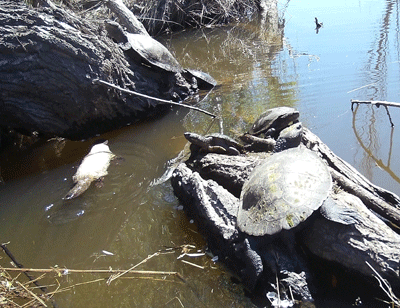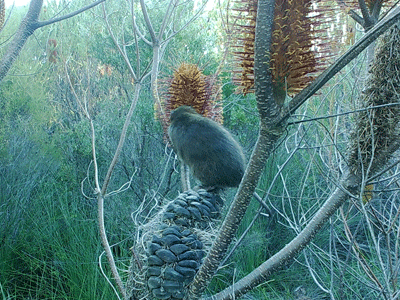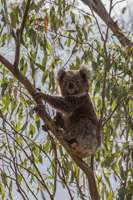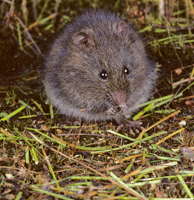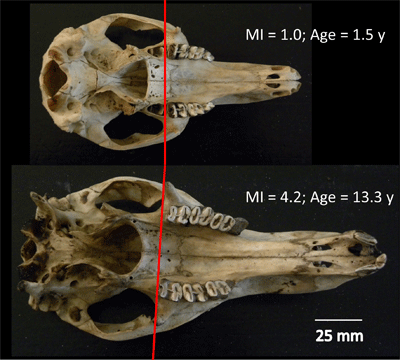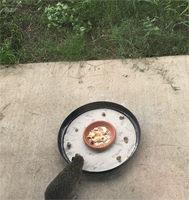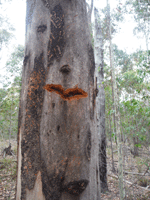The Black Summer wildfires impacted many native mammals, including threatened species that are restricted in distribution, such as the broad-toothed rat (Mastacomys fuscus). Although the fires severely burnt over 30% of Kosciuszko National Park, a stronghold for this species, subsequent surveys have shown in the last 3 years that the broad-toothed rat has re-appeared in 66% of locations where it had been recorded pre-fire. This finding suggests that, over time, it will repopulate severely burnt areas as long as refugia are present, combined with other management activities, such as the control of large herbivores that impact vegetation regeneration.
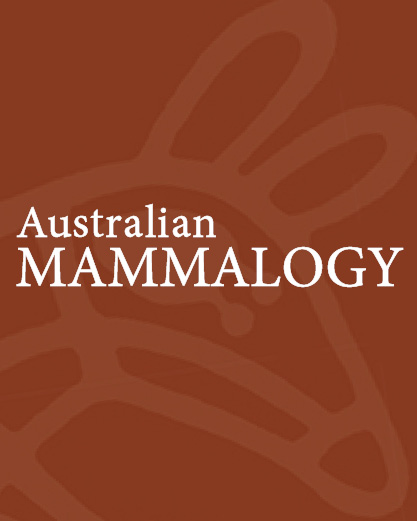
Australian Mammalogy
Volume 46 Number 1 2024
This study examines the stomach and scat contents of collections of southern brown bandicoots (Isoodon obesulus) and eastern barred bandicoots (Perameles gunnii) in order to understand their role as fungal dispersers. We show that both species are performing important ecosystem functions through the dispersal of mycorrhizal fungi.
The platypus is one of the world’s most extraordinary animals. Although many people may never encounter this unique mammal in the wild, we observed and captured footage of a rare white platypus! Our search of scientific literature, newspapers and databases yielded 12 novel records of albino or atypically white individuals dating back to 1835. Our observation likely represents the only known record of a leucistic platypus. Photograph by Louise Streeting.
AM23027 Abstract | AM23027 Full Text | AM23027PDF (1.7 MB) | AM23027Supplementary Material (2.8 MB) Open Access Article
Extinction can be challenging to determine. This is especially so for the Christmas Island shrew, Australia’s only representative of the diverse and widespread shrew family. The Christmas Island shrew has been reported only four times since 1900, with the most recent record in 1985. We apply a recently developed IUCN analytical tool, based on search effort, and conclude that there is a 96.3% chance that the species is extinct.
Our manuscript shows that 27 indigenous mammal species continue to decline across Australia’s 26 western-most bioregions. To inform conservation planning, we identify two environmental and three species variables that collectively explain 94% of the variation in faunal attrition across these bioregions. We also identify one species that needs to be re-evaluated to a higher threat category.
Knowledge of the role of Australian non-flying mammals in pollination is incomplete. Rodents were frequently captured visiting Banksia ericifolia in north-east New South Wales. Nocturnal pollen loads on grassland melomys were amongst the highest for an Australian non-flying mammal, suggesting an important role in the pollination of subtropical B. ericifolia. Photograph by R. Goldingay.
Legislation governing land clearing and development, as it relates to koala conservation, acts at the tree species level. We therefore aimed to describe which species of trees are preferentially used by koalas and found that eight species were used disproportionate to their availability, during either the day or night. To achieve koala conservation, it will be necessary to preserve a diverse mixture of tree species and sizes.
AM23041An observation of mating in free-living spotted-tailed quolls (Dasyurus maculatus gracilis)
Observations of mating behaviour in quolls are invariably made on captive animals, and the translation of these observations to the wild can be problematic. I report on an observation in the wild that confirms many aspects of captive observations, while adding new information on mating behaviour in the wild. This observation suggests that the very long mating (≥24 h) reported in captivity may be an artefact of confinement and describes a tell-tale trace left on the forest floor by mating quolls.
AM22041Records of leopard seals Hydrurga leptonyx ashore in South Australia, 2017–2022
Fourteen juvenile leopard seals were recorded in South Australia between November 2017 and November 2022; most were in fair/thin body condition and all were ashore between June and December. Necropsies on two specimens involved gross, histopathological, and diagnostic assessment of pathogens, organs, and skin lesions; they showed evidence of blunt trauma.
Populations of three small mammal species (swamp rat, broad-toothed rat and swamp antechinus) in montane moorland recovered after low severity planned burns as the vegetation recovered. However, recovery of vegetation and the swamp antechinus to pre-burn levels was slower following short fire intervals than long fire intervals. This information can assist managers to implement fire regimes for mammal conservation. (Broad‐toothed Rat by Dave Watts.)
AM23003Short range extension delineating the north-eastern limit, and use of atypical habitat by highland Leadbeater’s possum
We surveyed for Leadbeater’s possum in the stronghold of their distribution in the Central Highlands and at the north-eastern edge of their known range. Leadbeater’s possums were found in typical ash/snow gum-dominated forest and atypical habitat of non-ash/non-snow gum forest dominated by smooth-barked eucalypts, including the first recorded detection in Kybean mallee-ash. Our results extended and appear to have delineated the north-eastern limit of their occurrence. This will improve forest management modelling tools that are used to predict suitable habitat.
A female wild rabbit (Oryctolagus cuniculus) was captured 18 times between 26 October 2009 and 19 February 2019. The longevity of this rabbit, from its calculated birth date to the date of its last capture, was 9.5 years. We consider this to be a new lifespan record for a wild European rabbit.
AM23002The use of rope bridges to study the colonisation of restored rainforest habitat by arboreal mammals
Rainforest restoration helps to restore Australia’s biodiversity, but the maturity of restored habitats and their accessibility determines whether arboreal mammals colonise them. Images from motion-sensing cameras that were installed at an artificial crossing structure within restored rainforest verified the use of restored rainforest younger than 8 years by arboreal mammals. The results also suggest that crossing structures are important tools for facilitating access and use of restored rainforest habitat when it contains barriers for arboreal mammals.
The age of an animal affects every aspect of its biology. Almost 60 years ago, a researcher devised a way to estimate the age of captive kangaroos from their teeth, but the results have never been confirmed. We followed wild kangaroos through their whole lives and found that the estimates closely matched their true ages, so this method can now be used with confidence in kangaroo field studies. Photograph by Wendy J. King.
Some Australian mammals may not recognise introduced predators and are naïve to the threat they pose. We assessed how wild-caught bandicoots reacted to a variety of predators, and our results show that bandicoots may recognise a live dog or cat as a threat. Bandicoots may need to be trained to recognise and respond appropriately to some predator cues to maximise their chance of survival in the wild. Photograph by MC Edwards.
Tree sap is important in the diet of the yellow-bellied glider. Gliders are highly selective of the trees used in sap feeding. I investigated the use of 66 trees in the home ranges of 32 glider groups over 2 years. I use these data to show that sap tree monitoring can be a reliable way to demonstrate on-going occupancy of a home range. Photograph by R. Goldingay.
AM23037Australian terrestrial mammals: how many modern extinctions?
Australia has the unenviable record of the highest number of terrestrial mammal extinctions of any continent. This note updates the list of extinct Australian terrestrial mammal species and subspecies and, from published scientific literature, reports 40 species and six subspecies that are presumed to have become extinct since European settlement of Australia, significantly more than recorded in recent publications. The high number of mammals listed as threatened in Australian gives cause for concern that more species may become extinct.
AM23037 Abstract | AM23037 Full Text | AM23037PDF (753 KB) Open Access Article
Collecting meaningful radio tracking data for small mammals weighing <30 g relies on selecting radio transmitter attachment methods suitable for the target species while prioritising animal welfare. Developing a non-permanent radio transmitter attachment for house mice is challenging due to size and weight constraints. However, by trialling methods in the laboratory and field, we developed a suitable radio collar with an in-built weak-link. Our non-permanent weak-link radio collar is an important improvement on existing permanent radio collars for small mammals.
AM23017What’s in a name? Selection of common names among new and revised species of Australian mammals, and the case of the sugar glider†
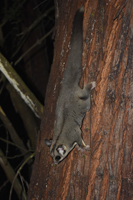
The common names of species serve an important role in communication. We review new common names given to Australian mammal species, particularly those applied following taxonomic revision of the sugar glider. Consistent with the guidelines of the Australian Mammal Society we propose the use of ‘inland’ and ‘coastal’ sugar gliders for these sibling species.
AM23012Interactions between adult male koalas and dependent joeys in a high-density population
We observed interactions between adult males and dependent joeys that were mostly passive in nature, suggesting that interactions with adult males are not a major threat to joey survival. However, one male–joey interaction resulted in a joey falling approximately 7 m to the ground, an incident that may have resulted in the death of the joey had we not intervened. We suggest that there is potential for infant death to occur under the generalised aggression hypothesis for koalas.
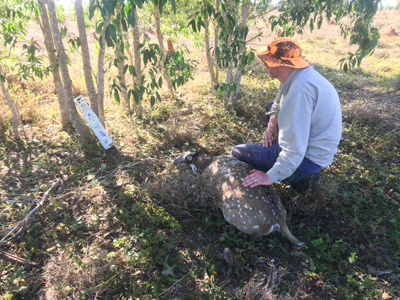
Capture of wild animals by land managers and researchers is essential for many reasons but has a risk of unwanted animal welfare outcomes. This study improves a technique of helicopter darting capture of wild chital deer (Axis axis) in northern Australia and reduces post release mortalities. The process of refining capture techniques described here can be implemented in methodologies for other species.
Landscape-scale feral cat control that maintains a feral cat detection rate at or below 10 cats per 100 km of linear transect is sufficient to conserve mulgara populations in the arid rangelands of Australia. But to fully understand the effects of cat predation on mulgara, further research involving an area with a high density of feral cats is required.



